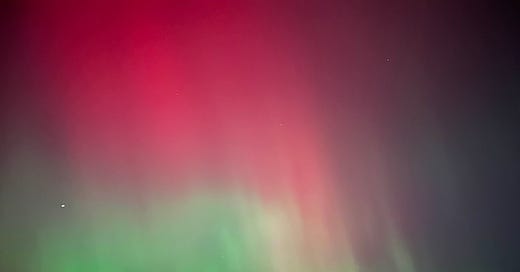Greetings!
Peace, mercy, and grace be with you from God our Father and the Lord Jesus Christ.
Greetings from northern Illinois! Nathaniel and I are visiting family. We are thankful for the opportunity to do so. We hope and pray all is well with all of you.
Sunday, October 27, 2024
The Voice 14.43: What Is Not in Romans 14:1-15:7
Our final foray into Romans 14:1-15:7 again considers how much of what passes for discussion about Romans 14:1-15:7 involves ideas either imported from other passages or ideological postures from other sources.
On its own, Romans 14:1-15:7 would seem pretty straightforward. It’s the kind of passage which many seem to want to make more complicated than it needs to be, and unfortunately with suspect motives. Paul put it all nicely in the end:
Receive one another, then, just as Christ also received you, to God’s glory (Romans 15:7).
Lesson: YHWH My Shepherd | Psalm 23:1-6 | Comfort in Psalm
I was thankful for the opportunity to preach for the Harlem Road church of Christ in Machesney Park, Illinois, and felt the lesson from Psalm 23:1-6 from a couple months back would be appropriate.
Since I’m in Illinois this week, I will share a photo my father was able to take of the aurora borealis which was visible there a couple of weeks ago. Truly majestic and marvelous.
Book Reviews
Sometimes it is better to consider a book about “current events” some time after those events to see how well they hold up. Most such books, I would hazard, do not age well. Those which do age well should cause one to sit down and take notice.
Christine Wicker published The Fall of the Evangelical Nation: The Surprising Crisis Inside the Church (affiliate link) in 2009. Her analysis has held up quite well in the intervening 15 years.
To well understand this book, one must attempt to mentally return to what might have seemed as the halcyon days of American Evangelicalism before the election of Barack Obama. George W. Bush was reckoned as one of the most Evangelical Christians ever to inhabit the White House, and had made much of his Evangelical background; social discourse was all about Evangelical Christianity and its robust strength in society. They were still mocking the mainline for the latter’s decline.
Yet just like there were signs of trouble before the economic collapse of 2006, so the author well perceived the signs of trouble within American Evangelicalism. The author had a background and heritage within Evangelical Christianity, but had moved away from it as an adult. So, sure, she was an “exvangelical” before the term was popularized, but she did not hold any ill will to the faith of her youth. In fact, throughout the book she validated the legitimacy and integrity of the faith of many Evangelicals. In many respects the book is about the particular predicament of America in the aughts (and ever since): how come this faith, which provided so much meaning and a sense of purpose and community for its dedicated adherents, did not have nearly as many dedicated adherents as imagined, and was not really gaining much interest?
What was at the time being kept well behind the scenes were the difficulties which the author had perceived: behind all the statistics suggesting how a significant minority of Americans were Evangelical Christians, the author discovered the number of truly dedicated Evangelical Christians were far, far fewer, only a few percent of the American population. The “growth” in American Evangelicalism being bandied about and paraded around seemed to come mostly from “church transfers” rather than the conversion of secular Americans. The youth were not taking to the faith as strongly as had previous generations. Moral hypocrisy and scandal proved far too prevalent and discouraging. And what was seeming to be the strong model of the megachurch was not; based around the personality of the senior pastor, the track record of megachurches enduring much beyond a generation was not good.
All the trends the author noticed would become all the more evident ever since, and all the more so since the COVID-19 pandemic. Religious “nones” are now the majority of the population. Moral hypocrisy and scandal have led to even more of an exodus from Christianity than ever before. The politicization of American Evangelicalism, in full blossom of strength before 2008, has become complete, with a not insignificant number of Americans identifying as Evangelical because they think it means association with being a MAGA reactionary than anything involving the Jesus of the Gospels.
The author was not wrong. Evangelical Christianity was not really growing in the 21st century. It was not really driving culture; culture was driving it. Christian nationalism will not be the way forward; clinging to a particular political leader will not be the way forward; the way forward will have to be with the expectation and understanding Christians will be a cultural minority, will maintain countercultural values, and will be at its best when embodied in a local community.
But we have to reject the boosterism and delusions of the gaudy marketed face of American Evangelicalism before Christians can better reflect Jesus to modern America.
United States History courses tend to make much out of a little; after all, the United States of America is not even yet 250 years old. But North America is far older.
Tim Flannery provides the ultimate in American history in The Eternal Frontier: An Ecological History of North America and Its Peoples (affiliate link), covering 65 million years from the Chicxulub asteroid impact until the modern day.
As an ecological history, the work focuses on what we have learned about the flora and fauna, especially the fauna, of the North American continent. It is believed said continent has moved a lot, expanded its boundaries, had inland seas come and go, watched a few mountain ranges rise and fall - and of greater consequence, came into contact with Eurasia, broke off contact with Eurasia, and connected with South America.
Thus the narrative describes the ascent of mammals after the asteroid impact and plant development; Eurasian migrants to North America, with a couple of key North Americans immigrating to Europe, including the horse; eventual isolation from Eurasia, and eventual contact with South America, and how many more species traveled north from South America than vice versa, including most of our migratory birds.
The big story more recently involved Ice Ages, the development of the American megafauna, and the eventual death of the megafauna, most likely at the hands of early Indigenous people. The author is very committed to the Clovis people as the first Indigenous Americans; one can only wonder what he would make of the most recent evidence suggesting the presence of people well before 13,000 years ago.
According to the author, North America has never really gotten over the end of its megafauna. Sure, Indigenous people persevere for generations afterward, but such explains why the bison became so important as the last remnant of the megafauna. And then the Europeans arrived with all kinds of new exchanges.
The last two centuries in particular have been nothing but a disaster ecologically for North America, well exemplified by the author in terms of the stories of the passenger pigeon and the bison. Resources which developed over long periods of time have been quickly exploited and extracted.
Those who may find the millions of years a difficult prospect to entertain can do well imagining it all happening over a shorter time, or as a heritage imbued in the rock from its creation. What should not be missed is the story we can read from the ecological heritage of North America. The geography of North America means it experiences climate change more sharply and violently than other parts of the world; we should not be surprised if our climate varies more sharply and violently over the next few generations. North America will remain resilient; its present flora and fauna, however, maybe not so much.
This is an interesting read in order to get a fuller picture of the heritage of North America.
May the grace and peace of our Lord Jesus Christ be with your spirits.
Ethan






